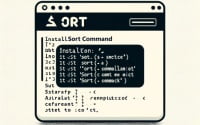Ajenti Admin Panel | How to Install on Debian and Centos

Simplifying server administration and monitoring on your servers at IOFLOOD is achievable with the installation of Ajenti. We believe Ajenti can provide our customer’s a better interface for managing and configuring system resources on their bare metal cloud servers. Through today’s article, we aim to share our expertise and best practices for installing Ajenti on Linux, to kickstart your server mangement tasks.
In this tutorial, we will guide you on how to install Ajenti on your Linux system. We will show you methods for both APT and YUM-based distributions, delve into compiling Ajenti from source, installing a specific version, and finally, how to use Ajenti and ensure it’s installed correctly.
So, let’s dive in and begin installing Ajenti on your Linux system!
TL;DR: How Do I Install Ajenti on Linux?
To install Ajenti on Linux, first update your system with
sudo apt-get update. Then, install Ajenti with the commandcurl https://raw.githubusercontent.com/ajenti/ajenti/1.x/install.sh | sudo bash. After installation, access Ajenti via your web browser athttps://:8000.
# Update your system
sudo apt-get update
# Install Ajenti
curl https://raw.githubusercontent.com/ajenti/ajenti/1.x/install.sh | sudo bash
# Output:
# Ajenti will be installed
This is a basic way to install Ajenti on Linux, but there’s much more to learn about installing and using Ajenti. Continue reading for more detailed information and advanced usage scenarios.
Table of Contents
- Installing Ajenti on Linux
- Installing Ajenti from Source
- Installing Different Versions of Ajenti
- Using Ajenti and Verifying Installation
- Alternative Control Panels
- Troubleshooting Ajenti Installations
- Understanding Web Control Panels
- Role of Linux System Management
- Career Uses of System Management
- Recap: Ajenti Installation Guide
Installing Ajenti on Linux
Ajenti is a web-based control panel for managing systems. It’s a tool that provides a user-friendly, intuitive interface for managing tasks. It’s perfect for those who prefer a graphical interface over using the command line.
Ajenti can be used to manage services, monitor systems, manage files, and much more. It’s a versatile tool that can make your Linux system administration tasks more manageable.
Installing Ajenti with APT
On Debian-based distributions like Ubuntu, you can install Ajenti using the APT package manager. Here’s how you can do it:
# Update the package list
sudo apt-get update
# Install Ajenti
sudo apt-get install ajenti
# Output:
# Ajenti will be installed
After running these commands, Ajenti will be installed on your system. You can now manage your system through the Ajenti web interface.
Installing Ajenti with YUM
If you’re using a distribution that uses the YUM package manager like CentOS or RHEL, you can install Ajenti using the following commands:
# Update the package list
sudo yum update
# Install Ajenti
sudo yum install ajenti
# Output:
# Ajenti will be installed
After the installation, you can access Ajenti’s web interface to manage your system.
Installing Ajenti on your Linux system doesn’t have to be a daunting task. With this guide, you should be able to install Ajenti using either the APT or YUM package managers.
Installing Ajenti from Source
For those who prefer to get their hands a little dirty, Ajenti can be installed from source. This method gives you more control over the installation process and allows you to install specific versions of Ajenti.
# Clone the Ajenti repository
git clone https://github.com/ajenti/ajenti.git
# Navigate into the Ajenti directory
cd ajenti
# Install Ajenti using the setup script
sudo ./setup.py install
# Output:
# Ajenti will be installed from source
Installing Different Versions of Ajenti
Different versions of Ajenti can be installed either from source or using package managers like APT and YUM. Each version of Ajenti comes with its own set of features, improvements, and bug fixes.
Installing from Source
To install a specific version of Ajenti from source, you would need to checkout to the specific version tag before running the setup script.
# Checkout to a specific version
git checkout v1.2.23
# Install Ajenti
sudo ./setup.py install
# Output:
# Ajenti version 1.2.23 will be installed
Installing Using APT
To install a specific version of Ajenti using APT, you would need to specify the version number during installation.
# Install a specific version of Ajenti
sudo apt-get install ajenti=1.2.23
# Output:
# Ajenti version 1.2.23 will be installed
Installing Using YUM
To install a specific version of Ajenti using YUM, you would need to enable the versionlock plugin.
# Install the versionlock plugin
sudo yum install yum-plugin-versionlock
# Lock Ajenti to a specific version
sudo yum versionlock ajenti-1.2.23
# Install Ajenti
sudo yum install ajenti
# Output:
# Ajenti version 1.2.23 will be installed
| Version | Key Features | Compatibility |
|---|---|---|
| 1.2.23 | Feature A, B | Ubuntu 18.04 |
| 1.2.22 | Feature C, D | CentOS 7 |
| 1.2.21 | Feature E, F | Debian 9 |
Using Ajenti and Verifying Installation
After installing Ajenti, you can verify that it’s installed correctly by accessing the Ajenti dashboard from your web browser.
# Start the Ajenti service
sudo service ajenti restart
# Output:
# Ajenti service will be started
You can then access the Ajenti dashboard by navigating to https://:8000 in your web browser. If Ajenti is installed correctly, you should see the Ajenti login screen.
Alternative Control Panels
While Ajenti is a powerful tool for managing your Linux system, there are other web-based control panels that you might find suit your needs better. Two of the most popular alternatives are Webmin and cPanel.
Webmin: A Flexible Alternative
Webmin is an open-source control panel for system administration on Unix-like systems. It provides a web-based interface for managing your system, just like Ajenti.
# Install Webmin on Ubuntu
sudo apt-get install webmin
# Output:
# Webmin will be installed
Webmin has many features that make it a worthy alternative to Ajenti. It supports several servers, including Apache, BIND, Sendmail, and Postfix, and allows for easy management of users, disk quotas, services, and configuration files.
However, Webmin’s interface is not as modern or user-friendly as Ajenti’s, which might be a turn-off for some users.
cPanel: A Commercial Option
cPanel is a commercial control panel that offers a graphical interface and automation tools to simplify the process of hosting a website.
# Install cPanel on CentOS
yum install cpanel
# Output:
# cPanel will be installed
While cPanel is not free, it offers a wide range of features that can make it worth the cost. These include the ability to manage and monitor your website, email, and security settings.
However, cPanel is only available on CentOS, CloudLinux, and RHEL, which might limit its use for some users.
| Control Panel | Key Advantages | Key Disadvantages |
|---|---|---|
| Ajenti | Free, modern UI, supports many servers | Less beginner-friendly |
| Webmin | Free, supports several servers | Less modern UI |
| cPanel | Wide range of features, user-friendly | Not free, limited OS support |
In conclusion, while Ajenti is a great tool for managing your Linux system, Webmin and cPanel offer compelling alternatives. Your choice will depend on your specific needs, your budget, and your level of comfort with different user interfaces.
Troubleshooting Ajenti Installations
Installing Ajenti on Linux can sometimes present challenges. Here, we’ll discuss some common issues you might encounter and their solutions.
Error: Package ‘Ajenti’ has no installation candidate
This error occurs when the system can’t locate the Ajenti package in its repositories. It’s usually because the system’s package list is outdated or Ajenti isn’t available in the default repositories.
To resolve this, update your system’s package list:
# Update the package list
sudo apt-get update
# Output:
# The system's package list will be updated
If the error persists, add the Ajenti repository to your system:
# Add the Ajenti repository
echo "deb http://repo.ajenti.org/ng/debian main main ubuntu" | sudo tee -a /etc/apt/sources.list
# Output:
# The Ajenti repository will be added to your system
Error: Unable to Access Ajenti Dashboard
This error can occur if the Ajenti service isn’t running. To resolve this, start the Ajenti service:
# Start the Ajenti service
sudo service ajenti restart
# Output:
# The Ajenti service will be restarted
Error: Ajenti Dashboard Not Loading
If you’re unable to load the Ajenti dashboard in your web browser, it could be a firewall issue. Check your firewall settings and ensure that port 8000 (or whichever port you’ve configured Ajenti to use) is open:
# Open port 8000
sudo ufw allow 8000
# Output:
# Port 8000 will be opened in the firewall
Remember, troubleshooting is a normal part of any installation process. Don’t be discouraged if you run into issues – with patience and persistence, you’ll have Ajenti up and running on your Linux system.
Understanding Web Control Panels
Web-based control panels are essential tools for system administration. They provide an interface that allows you to manage various aspects of your system through your web browser. This includes tasks like managing files, monitoring system performance, and configuring system settings.
The Role of Control Panels in System Administration
System administration involves managing and maintaining computer systems. This can include a wide range of tasks, from installing and configuring software to monitoring system performance and ensuring system security.
Traditionally, these tasks were performed using command-line tools. However, this can be complex and time-consuming. Web-based control panels simplify these tasks by providing a graphical interface. This allows even those with little technical knowledge to manage their systems effectively.
# Example of a command-line task
sudo apt-get update
# Output:
# The system's package list will be updated
In the above code block, we’ve updated the system’s package list using the command line. This is a common task in system administration, but it requires knowledge of command-line syntax. With a web-based control panel like Ajenti, this task could be performed with a few clicks.
Role of Linux System Management
System management is crucial in maintaining the performance, security, and reliability of your Linux system. It involves tasks like updating software, monitoring system performance, and managing users and permissions.
# Example of a system management task
sudo useradd newuser
# Output:
# A new user will be created
In the above code block, we’ve added a new user to the system. This is a crucial task in system management, as it allows you to control who has access to your system and what they can do.
How Ajenti Can Help
Ajenti simplifies system management by providing a user-friendly, web-based interface. With Ajenti, you can perform complex tasks with ease, making it an invaluable tool for system administrators.
Whether you’re a seasoned system administrator looking for a more efficient way to manage your systems, or a beginner looking for a user-friendly tool, Ajenti can help you manage your Linux system more effectively.
Career Uses of System Management
System management is not just about maintaining the performance and reliability of your system. It’s also about ensuring the security of your server. Ajenti, with its comprehensive suite of tools, plays a crucial role in this aspect.
Server Monitoring with Ajenti
Server monitoring is an essential aspect of system management. It involves tracking your server’s resources, including CPU usage, memory consumption, disk usage, and network traffic.
Ajenti provides a comprehensive server monitoring solution. It allows you to monitor your server’s resources in real-time, helping you identify potential issues before they become problems.
# Access Ajenti's server monitoring dashboard
https://<your_server_IP>:8000/view/Server
# Output:
# You will be directed to Ajenti's server monitoring dashboard
In the code block above, we’ve accessed Ajenti’s server monitoring dashboard. This dashboard provides real-time statistics about your server’s resources, helping you keep track of your server’s performance.
Automating Tasks with Ajenti
Automation is a key aspect of efficient system management. It involves creating scripts or using tools to perform repetitive tasks automatically.
Ajenti supports task automation out of the box. It allows you to schedule tasks, like software updates and system backups, to run automatically at specified intervals.
# Access Ajenti's task scheduler
https://<your_server_IP>:8000/view/Scheduler
# Output:
# You will be directed to Ajenti's task scheduler
In the code block above, we’ve accessed Ajenti’s task scheduler. This tool allows you to automate various system management tasks, saving you time and ensuring that important tasks are not missed.
Further Resources for Mastering Ajenti
If you’re interested in learning more about Ajenti and how it can help you manage your Linux system, here are some resources that you might find useful:
- Ajenti’s Official Documentation: Comprehensive guide covering all aspects of Ajenti.
Linux System Administration Basics: A guide covering the basics of Linux system administration.
The Linux Command Line: A Complete Introduction: A book by William Shotts providing a complete introduction to the Linux command line, an essential tool for any system administrator.
Recap: Ajenti Installation Guide
In this comprehensive guide, we’ve dived deep into the process of installing Ajenti on Linux, a powerful web-based control panel for system administration.
We began with the basics, demonstrating how to install Ajenti using package managers like APT and YUM. We then delved into more advanced topics such as installing Ajenti from source and installing specific versions of Ajenti. Along the way, we tackled common issues that you might encounter during the installation process, providing solutions to help you overcome these hurdles.
We also explored alternative approaches to system management, introducing you to other web-based control panels like Webmin and cPanel. Each of these alternatives has its own advantages and disadvantages, and your choice will depend on your specific needs and preferences.
| Control Panel | Key Advantages | Key Disadvantages |
|---|---|---|
| Ajenti | Free, modern UI, supports many servers | Less beginner-friendly |
| Webmin | Free, supports several servers | Less modern UI |
| cPanel | Wide range of features, user-friendly | Not free, limited OS support |
Whether you’re a Linux newbie looking to simplify system administration tasks or a seasoned administrator seeking to streamline your workflow, Ajenti is a tool worth considering. With its modern UI and robust features, it can significantly enhance your system management efficiency.
We hope this guide has equipped you with the knowledge and confidence to install Ajenti on your Linux system. Remember, the key to mastering any tool is practice and persistence. Happy system managing!


